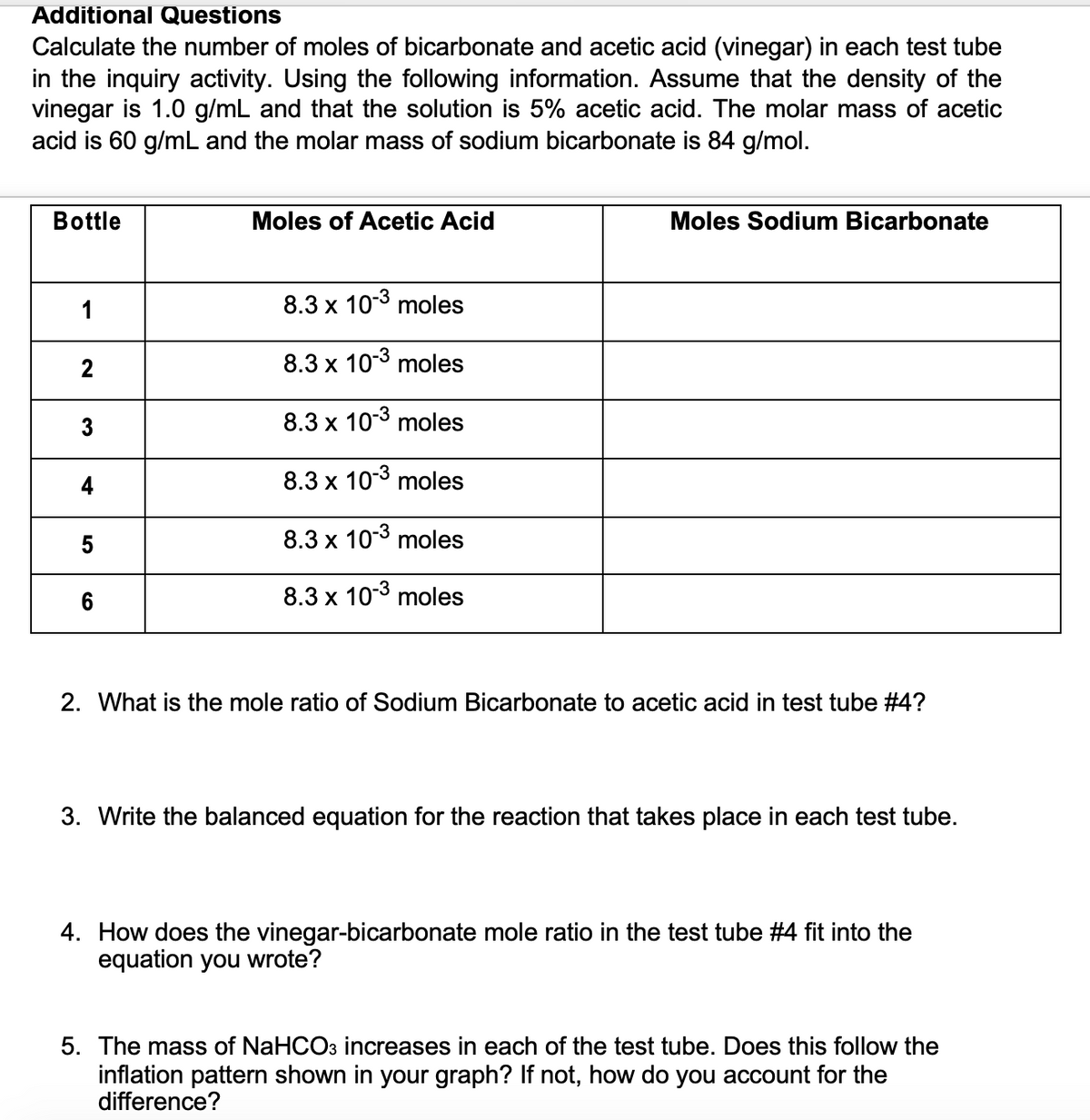Calculate the number of moles of bicarbonate and acetic acid (vinegar) in each test tube in the inquiry activity. Using the following information. Assume that the density of the vinegar is 1.0 g/mL and that the solution is 5% acetic acid. The molar mass of acetic acid is 60 g/mL and the molar mass of sodium bicarbonate is 84 g/mol.
Calculate the number of moles of bicarbonate and acetic acid (vinegar) in each test tube in the inquiry activity. Using the following information. Assume that the density of the vinegar is 1.0 g/mL and that the solution is 5% acetic acid. The molar mass of acetic acid is 60 g/mL and the molar mass of sodium bicarbonate is 84 g/mol.
Chemistry
10th Edition
ISBN:9781305957404
Author:Steven S. Zumdahl, Susan A. Zumdahl, Donald J. DeCoste
Publisher:Steven S. Zumdahl, Susan A. Zumdahl, Donald J. DeCoste
Chapter1: Chemical Foundations
Section: Chapter Questions
Problem 1RQ: Define and explain the differences between the following terms. a. law and theory b. theory and...
Related questions
Question

Transcribed Image Text:Additional Questions
Calculate the number of moles of bicarbonate and acetic acid (vinegar) in each test tube
in the inquiry activity. Using the following information. Assume that the density of the
vinegar is 1.0 g/mL and that the solution is 5% acetic acid. The molar mass of acetic
acid is 60 g/mL and the molar mass of sodium bicarbonate is 84 g/mol.
Bottle
Moles of Acetic Acid
Moles Sodium Bicarbonate
1
8.3 x 103 moles
2
8.3 x 103 moles
3
8.3 x 103 moles
4
8.3 x 103 moles
5
8.3 x 103 moles
6
8.3 x 103 moles
2. What is the mole ratio of Sodium Bicarbonate to acetic acid in test tube #4?
3. Write the balanced equation for the reaction that takes place in each test tube.
4. How does the vinegar-bicarbonate mole ratio in the test tube #4 fit into the
equation you wrote?
5. The mass of NaHCO3 increases in each of the test tube. Does this follow the
inflation pattern shown in your graph? If not, how do you account for the
difference?
Expert Solution
This question has been solved!
Explore an expertly crafted, step-by-step solution for a thorough understanding of key concepts.
This is a popular solution!
Trending now
This is a popular solution!
Step by step
Solved in 2 steps

Follow-up Questions
Read through expert solutions to related follow-up questions below.
Follow-up Question
Calculate the number of moles of acetic acid. Assume that the density of the vinegar is 1.0 g/mL and that the solution is 5% acetic acid. The molar mass of acetic acid is 60 g/mL and the molar mass of sodium bicarbonate is 84 g/mol.
Solution
Knowledge Booster
Learn more about
Need a deep-dive on the concept behind this application? Look no further. Learn more about this topic, chemistry and related others by exploring similar questions and additional content below.Recommended textbooks for you

Chemistry
Chemistry
ISBN:
9781305957404
Author:
Steven S. Zumdahl, Susan A. Zumdahl, Donald J. DeCoste
Publisher:
Cengage Learning

Chemistry
Chemistry
ISBN:
9781259911156
Author:
Raymond Chang Dr., Jason Overby Professor
Publisher:
McGraw-Hill Education

Principles of Instrumental Analysis
Chemistry
ISBN:
9781305577213
Author:
Douglas A. Skoog, F. James Holler, Stanley R. Crouch
Publisher:
Cengage Learning

Chemistry
Chemistry
ISBN:
9781305957404
Author:
Steven S. Zumdahl, Susan A. Zumdahl, Donald J. DeCoste
Publisher:
Cengage Learning

Chemistry
Chemistry
ISBN:
9781259911156
Author:
Raymond Chang Dr., Jason Overby Professor
Publisher:
McGraw-Hill Education

Principles of Instrumental Analysis
Chemistry
ISBN:
9781305577213
Author:
Douglas A. Skoog, F. James Holler, Stanley R. Crouch
Publisher:
Cengage Learning

Organic Chemistry
Chemistry
ISBN:
9780078021558
Author:
Janice Gorzynski Smith Dr.
Publisher:
McGraw-Hill Education

Chemistry: Principles and Reactions
Chemistry
ISBN:
9781305079373
Author:
William L. Masterton, Cecile N. Hurley
Publisher:
Cengage Learning

Elementary Principles of Chemical Processes, Bind…
Chemistry
ISBN:
9781118431221
Author:
Richard M. Felder, Ronald W. Rousseau, Lisa G. Bullard
Publisher:
WILEY